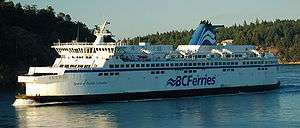S-class ferry
 Spirit of British Columbia | |
| Class overview | |
|---|---|
| Operators: | BC Ferries |
| Preceded by: | Victoria Class, Cowichan Class |
| Built: | 1992 to 1994 |
| In service: | 1993 to present |
| Building: | 2 |
| Completed: | 2 |
| Active: | 2 |
| General characteristics [1][2] | |
| Type: | S class ferry |
| Displacement: | 11,681 tonnes |
| Length: | 167 m (547 ft 11 in) |
| Installed power: | 21,394 hp (16 MW) |
| Propulsion: | Four MAN-B&W 6L 40/54 |
| Speed: | 19.5-knot (36.1 km/h) |
| Capacity: |
|
S-Class ferries (also known as Spirit Class ferries or Super ferries) are RORO ferries operated by BC Ferries in British Columbia, Canada. They are the largest ferries in the BC Ferries fleet.[3]
History
There are two Spirit Class Ferries — Spirit of British Columbia (built 1993)[1] and Spirit of Vancouver Island (built 1994).[2] The vessels are largely the same in layout and characteristics and both ferries were built (using the same method) in separate parts by a variety of different shipbuilders.
The 200 ft. bow hull pieces were built at Allied Shipbuilders in North Vancouver, while the 340 ft. stern hull pieces were built at Yarrows Ltd. in Victoria. The pieces were joined in Esquimalt before being towed to Fraser Surrey Docks. There they were joined with the superstructure, which had been constructed in 3 pieces along the Fraser River in Delta. Once the superstructure was complete the ships were returned to Esquimalt for finishing touches. Each ship cost roughly $130 million and took two or three years to complete.[3][4]
Spirit of British Columbia underwent extensive internal renovations in 2005 costing roughly $14 million. In January 2006, similar renovations on Spirit of Vancouver Island were completed.[3][4]
As of March 24, 2016, BC ferries has announced that the 2 Spirit class vessels will be converted to operate on liquefied natural gas (LNG). The contract has been awarded to Remontowa Ship repair Yard S.A. of Gdansk, Poland totalling $140 million. The conversion will allow the vessels to run on dual-fuel beginning in 2017 and completing in 2019.
Last fiscal year BC Ferries spent $118 million on diesel fuel of which 2 Spriit Class vessels consumed approximately 16 per cent (approx $19 million). Converting the vessels to LNG along with 3 new dual-fuel Salish-Class vessels will go a long way to help with fare affordability as LNG cost significantly less than marine diesel. By utilizing LNG to fuel the Spirit-Class vessels, BC ferries expect to reduce CO2 emissions by 12,000 tonnes annually, which is equivalent to taking 2500 vehicle off the road per year.
In order to make the project financially viable, BC Ferries pursued funding under incentive programs to help offset any incremental capital costs associated with the use of LNG. The company has signed an agreement, subject to certain conditions, to receive up to $10 million contribution from FortisBC Energy Inc. as part of the Natural Gas for Transportation ("NGT") incentive funding. In addition to the LNG conversion, safety systems will be renewed or upgraded including the marine evacuation systems, rescue boats, fire detection system, public address system and installation of a local water mist fire protection system.
The passenger areas will receive an interior design refresh including new carpeting, renewed washroom interiors, an additional washroom on Deck 5, expanded gift shop and new coffee bar on Deck 6. Upgrades to the passenger elevators include renewal of mechanical and electrical drive components, emergency communication system as well as upgrades to the electrical control systems.
Planned renewal of navigation equipment, propulsion equipment components including rudders, steering system, bow thrusters and propeller blades will also occur during the MLUs. Installation of LED lighting and more efficient air conditioning equipment will reduce energy consumption.
BC Ferries is planning for the Spirit of British Columbia to be the first ship through the MLU and LNG conversion process and commence actual conversion from the fall of 2017 through the spring of 2018, and the Spirit of Vancouver Island's to follow the following year from the fall of 2018 to the spring of 2019. This schedule will allow for these two vessels, the largest in the fleet, to be in operation during the summer months when traffic is at its peak. [5]
Today
The vessels operate exclusively on the Highway 17 (Swartz Bay-Tsawwassen) route. Spirit of British Columbia is based at Tsawwassen,[3] while Spirit of Vancouver Island is based at Swartz Bay.[4] The ferries make 4 round trips between Vancouver Island and mainland BC per day.[3][4]
References
- 1 2 "Spirit of British Columbia profile from BC ferries". Retrieved 2012-06-20.
- 1 2 "Spirit of Vancouver Island profile from BC ferries". Retrieved 2012-06-20.
- 1 2 3 4 5 "Spirit of British Columbia profile from westcoastferries.ca". Retrieved 2012-06-20.
- 1 2 3 4 "Spirit of Vancouver Island profile from westcoastferries.ca". Retrieved 2012-06-20.
- ↑ "BC FERRIES AWARDS CONTRACT FOR SPIRIT-CLASS MID-LIFE UPGRADES Vessels to be converted to operate on liquefied natural gas (LNG)". Retrieved 2016-05-16.
| Preceded by V Class ferries |
BC Ferries Mainland-Island Flagship 1993 - 1999 |
Succeeded by PacifiCat Series |
| Preceded by PacifiCat Series |
BC Ferries Mainland-Island Flagship 2000 - Present |
Succeeded by incumbent |